Whitetail bucks need to replenish their lean, worn-down bodies after the breeding season, so hunting over a food source then is a perfectly logical strategy. But don’t limit your consideration of stand sites to obvious hotspots like oak flats and cropfields. Deer relish any sweet soft mast that remains available into late fall and winter, and the fact that such forage is commonly found within the relative safety of the woods and is ignored by most hunters makes it doubly attractive to wary mature bucks.
The Favorite Fruits of Whitetail Deer
The fruits of persimmon, wild pear, apple, crabapple, and papaw trees provide deer with critical calories in a tasty package. Their high sugar content produces a sorely needed burst of energy. And though many of the individual fruits will drop and be eaten in September and October, you can usually find anywhere from a handful to several hundred frozen morsels still clinging to trees as winter sets in.
Certain varieties of wild apple and crabapple will hold their fruit longer than others and can continue to draw deer into December. Persimmons, in particular, tend to mature late. They often become bright orange and sweet tasting only in October or November and will stay on the trees until well after the rut. On my own property, I’ve watched bucks visit persimmon trees right up until a few days before Christmas. If you can locate a few of these in your hunting area, you might have found the ticket to a late-season buck.

Wild persimmon cling to a branch in late November. Ulrike Leone from Pixabay
Honey locust pods are another late-season favorite. Deer often favor specific trees, so if you know where the locust trees are on your property, if can be worth your while to check them occasionally for fresh feeding sign.
Two Strategies for Hunting Fruit Trees
Once you pinpoint an area, or even an individual tree, with available fruit, look for tracks and trails to determine the direction from which deer will approach it. Then set up downwind at a comfortable shooting distance.
Late-season bucks may visit these sites anytime during the day, but they are most likely to show just before dark. One important exception, however, is when an overnight cold front passes through and strong gusts blow the fruits off the trees. Then, the bucks will be chowing down first thing in the morning. So monitor the weather with this in mind and be in your stand bright and early after a windy night.
Still-hunting may be the best tactic to employ if you’re faced with a fairly large area that has a number of fruit trees scattered throughout it. I like to sneak quietly along the edges of these places and glass from a distance. When I spot a good buck, I keep myself hidden and plan a stalk that lets me use the topography, cover, and wind to get within shooting range. I especially like this approach on bitterly cold days. Staying mobile allows me to ward off the chill while searching for a buck nibbling on the last frozen fruits of the season.






